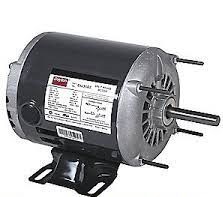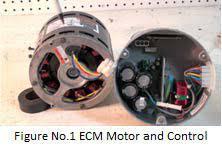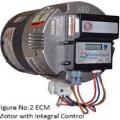Scope
Choose central air handler based HVAC equipment that uses a fan powered by
- An electronically commutated (ECM) motor
- Not a split capacitor motor
See the Compliance Tab for links to related codes and standards and voluntary federal energy-efficiency program requirements.
Description
Home owners who use an HVAC system with a central air handler fan can realize significant energy savings by using a fan with an electronically commutated (ECM) motor (see Figure 1).

Savings will be even larger for homeowners who run the HVAC fan continuously or frequently to filter the air or to bring in and circulate fresh air as part of a whole-house ventilation system. Because they are variable speed and can adjust their speed up or down to meet load, ECMs can operate on as little as 80 watts of electricity. In contrast, permanent split capacitor (PSC) engines are single-speed motors that typically consume between 500 and 550 watts when providing heating and cooling (Michael 2009).
Until recently PSC motors have been the most popular fan motor for furnaces, air handlers, condensing units, and packaged units (see Figure 2).

They are known for their simplicity, reliability, and low cost. However, these alternating current (AC) induction motors have inherent inefficiencies; they are at best 60% efficient and they generate excess heat which must be dealt with. PSC motors are not programmable and their motor speed cannot be easily varied.
ECM technology is based on a direct current (DC) design that is inherently about 80% efficient, compared to the 60% efficiency of a PSC motor, and they run cooler than PSC motor designs (Holliday 2011). The brushless design eliminates failures caused by worn brushes and commutators (see Figure 3).

ECM fans use about 400 watts in cooling mode and about 80 in continuous fan mode (Michael 2009). Because of their variable speed, they can run at low speeds for much of the time while PSC motors are typically on high speed all the time, so annual operating costs for ECMs can be 25% to 75% lower (Minnesota Power 2015).
The ability of ECMs to ramp up and ramp down slowly adds to their quiet operation and enhances their dehumidifying ability, especially when combined with a two-stage compressor and dehumidification controls. In dry climates, the ECM motor can be programmed for cooling at high speed followed by continued running of the fan at the end of the cooling cycle at a lower speed and watt draw to evaporate the water off the coil. In a wet climate, the controls are set differently for lower speed cooling, which provides more dehumidification in cooling mode, with the fan going off at the end of the compressor cycle to allow the coil to drain. Even when the system is set to “constant fan,” the fan still shuts down for 20 minutes at the end of the compressor cycle so the coil can drain. In climates that are sometimes dry and sometimes wet, an indoor thermidistat can be installed that will enable the motor controls to switch from dry climate programming to wet climate programming depending on the indoor conditions (Holliday 2011).
New HVAC equipment with ECMs installed typically costs 40% to 60% more than non-ECM based equipment (Michael 2009). Building America researchers note that ECM motors can reduce fan energy consumption by 50% or more over PSCs as long as the duct system is properly installed and constructed to eliminate excessive airflow resistance (Rudd 2011).
Both the IECC 2012 and the ENERGY STAR Certified Homes program require the use of an ECM fan motor if the home’s HVAC air handler will be used to distribute fresh air as part of a whole-house ventilation system. See the guide Whole House Ventilation Strategies for Existing Homes for more information. Alternately, ENERGY STAR permits non-ECM fan motors if the HVAC system has controls that will reduce the stand-alone ventilation run-time by accounting for hours when the HVAC system is heating or cooling while meeting code-required ventilation levels, such as those specified in ASHRAE Standard 62.2-2010/2013, Ventilation for Acceptable Indoor Air Quality in Low-Rise Residential Buildings. See manufacturers’ instructions for installing and setting the timer, damper, and controls.
Figure 4 shows a central-fan-integrated ventilation system that uses the air handler fan to distribute fresh air ducted directly to the return side of the air handler from outside. When the central air handler fan uses an ECM motor, the motor power draw will be about one-fourth of what it would be with a PSC motor when the system is operating in “fan-only” mode for ventilation.

Success
Specify high-performance HVAC equipment that includes an electronically commutated (ECM) fan motor.
If the whole-house ventilation system uses the HVAC central air handler, then the fan motor should be a variable speed electronically commutated motor (ECM) or an integral control motor (ICM) that includes a controller (e.g., a smart cycler) that reduces the ventilation run time by accounting for hours when the HVAC system is already operating the fan for heating or cooling the home.
Climate
No climate-specific guidance is provided.
Training
Compliance
Retrofit
Inexpensive replacement ECM motors can be installed to replace PSC motors in existing equipment while offering many of the benefits of ECMs, including high efficiency, variable speed, and quiet operation, at a lower cost.
Home owners may consider replacing just the PSC motor rather than the whole furnace or heat pump, if the motor fails prematurely. (Motor-only replacement is not recommended if the system is more than 10 years old per Michael 2009). PSC motors typically fail in one of three ways: the bearings, the capacitor, or the windings. A PSC that has seized will be obvious – it can’t be turned by hand, or it will be clearly noisy, ratchety, or resistant. A multi-meter can be used to identify the other two situations. One company offers a troubleshooting tip sheet for testing PSC capacitors and windings (this example is an oil burner motor).
Comfort improvements alone may warrant replacing a PSC motor with an ECM. Homeowners often appreciate the quiet operation, controllability and improved thermal comfort in part-load situations afforded by an ECM.
Energy savings can also be significant. In some cases, energy savings may cover the cost of a replacement ECM in just a few years, arguing for the change even before a PSC has failed. This may be true in a climate where the fan is blowing most days of the year or when a central HVAC system is used to distribute ventilation air, increasing fan run time. For example, one utility estimated that motor replacement with an ECM offered a less than 3-year simple payback and over $700 in operating cost savings over a 10-year period. ECM upgrades for fans and pumps sometimes qualify for local utility energy rebates. Check your utility’s website or the DOE Database of State Incentives for Renewables & Efficiency. In some temperate climate zones, the savings from an ECM motor may not justify the added cost. In this case an upgrade might still be justified for noise and comfort improvements. Table 1 outlines some of the differences between PSC motors and ECMs.
Table 1. ECM vs PSC Motors
| ATTRIBUTE | PSC | ECM |
|---|---|---|
| Expected lifespan | 40,000 to 50,000 hrs. (about 5 yrs) | 90,000 hrs. (about 10 yrs) |
| Cost | typical | 40-60% premium over PSC; generally short payback period of < 3 yrs |
| Noise | more | Less due to soft start, variable speeds |
| Comfort | Single speed can result in stagnation or draft due to cycling | Meets comfort at part load with varying flows to match demand, per furnace capabilities |
| Efficiency | Less than 60% | Up to 80% |
| Controllability | One to three defined speeds; can’t effectively or efficiently support ventilation | Variable speeds, can be programmed to achieve additional comfort goals, such as: Arid locations - high speed for cooling, followed by low speed to evaporate moisture off the cooling coils to re-humidify air Humid locations - reduced-velocity air flow to improve dehumidification |
| Other | Sometimes local utilities offer tax credits or rebates; ECMS run cooler than PSCs, dumping less heat to the space |
If considering a motor replacement, don’t ignore systemic problems such as leaky, kinked, or undersized duct systems. Adding an ECM motor to a leaky or poorly balanced system may actually increase energy use and noise, since the motor will ramp up to overcome the distribution inadequacies. Duct systems with an overly high pressure drop (e.g., more than 1-inch water column static pressure) have been shown to cause ECM motors to burn out and fail prematurely. While a PSC motor will stop pushing if the pressure is too high, an ECM will continue to work harder to push air through, wasting energy and eventually burning out. Take into account the size and condition of the current ducts when considering the energy saving potential of replacing a PSC engine with an ECM (Rudd 2011) and always repair ductwork (seal gaps, straighten kinks, balance the entire system) before investing in an ECM upgrade.
More
More Info.
Access to some references may require purchase from the publisher. While we continually update our database, links may have changed since posting. Please contact our webmaster if you find broken links.





